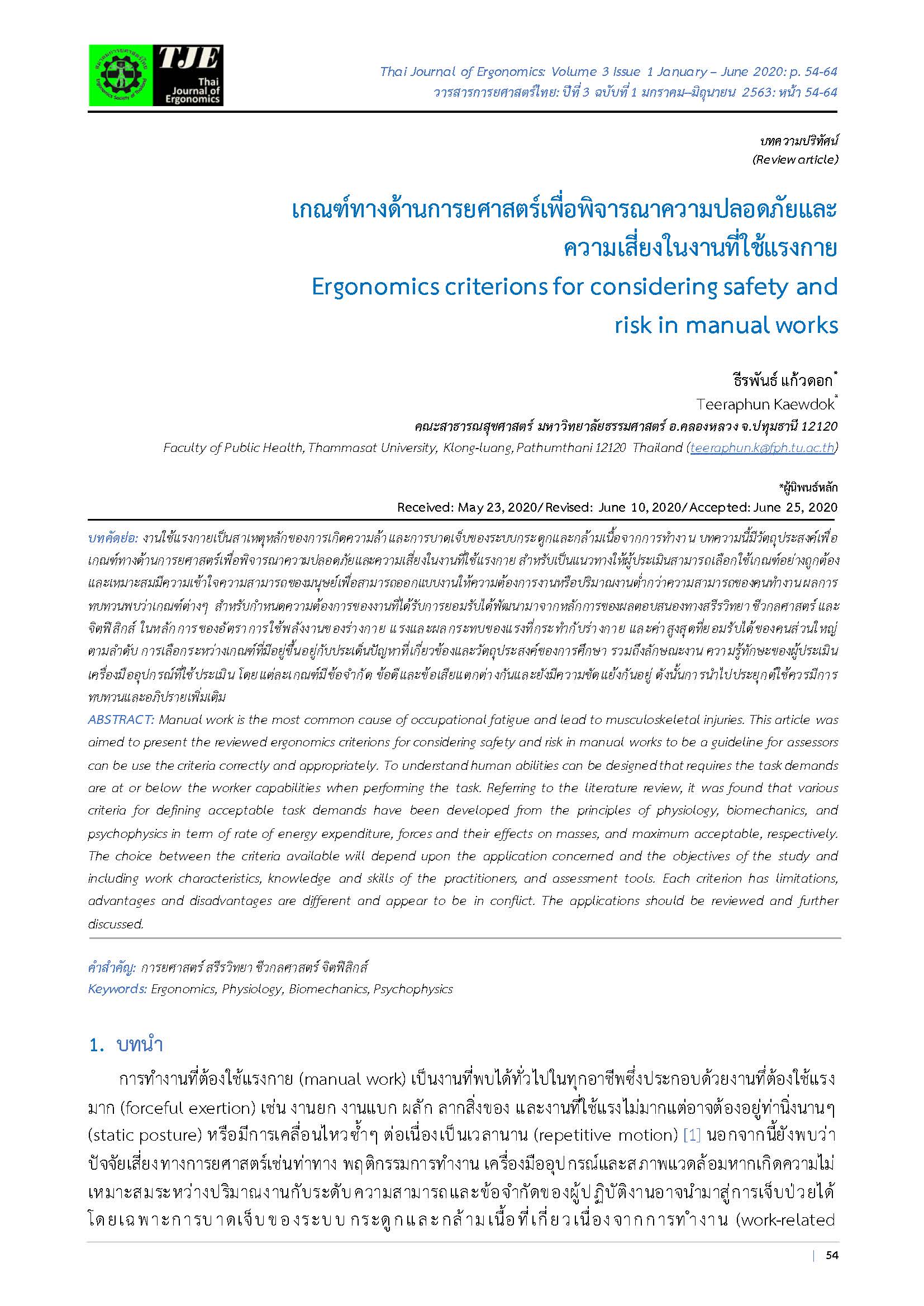เกณฑ์ทางด้านการยศาสตร์เพื่อพิจารณาความปลอดภัยและ ความเสี่ยงในงานที่ใช้แรงกาย
Main Article Content
บทคัดย่อ
งานใช้แรงกายเป็นสาเหตุหลักของการเกิดความล้าและการบาดเจ็บของระบบกระดูกและกล้ามเนื้อจากการทำงาน บทความนี้มีวัตถุประสงค์เพื่อเกณฑ์ทางด้านการยศาสตร์เพื่อพิจารณาความปลอดภัยและความเสี่ยงในงานที่ใช้แรงกาย สำหรับเป็นแนวทางให้ผู้ประเมินสามารถเลือกใช้เกณฑ์อย่างถูกต้องและเหมาะสมมีความเข้าใจความสามารถของมนุษย์เพื่อสามารถออกแบบงานให้ความต้องการงานหรือปริมาณงานต่ำกว่าความสามารถของคนทำงาน ผลการทบทวนพบว่าเกณฑ์ต่างๆ สำหรับกำหนดความต้องการของงานที่ได้รับการยอมรับได้พัฒนามาจากหลักการของผลตอบสนองทางสรีรวิทยา ชีวกลศาสตร์ และจิตฟิสิกส์ ในหลักการของอัตราการใช้พลังงานของร่างกาย แรงและผลกระทบของแรงที่กระทำกับร่างกาย และค่าสูงสุดที่ยอมรับได้ของคนส่วนใหญ่ ตามลำดับ การเลือกระหว่างเกณฑ์ที่มีอยู่ขึ้นอยู่กับประเด็นปัญหาที่เกี่ยวข้องและวัตถุประสงค์ของการศึกษา รวมถึงลักษณะงาน ความรู้ทักษะของผู้ประเมิน เครื่องมืออุปกรณ์ที่ใช้ประเมิน โดยแต่ละเกณฑ์มีข้อจำกัด ข้อดีและข้อเสียแตกต่างกันและยังมีความขัดแย้งกันอยู่ ดังนั้นการนำไปประยุกต์ใช้ควรมีการทบทวนและอภิปรายเพิ่มเติม
Article Details

This work is licensed under a Creative Commons Attribution-NonCommercial-NoDerivatives 4.0 International License.
References
นริศ เจริญพร. เอกสารประกอบการสอนชุดวิชาการยศาสตร์.พิมพ์ครั้งที่ 2. นนทบุรี: โรงพิมพ์
มหาวิทยาลัยสุโขทัยธรรมาธิราช; 2554.
Kee D, Karwowski W. A comparison of three observational techniques for assessing postural
loads in industry. International journal of occupational safety and ergonomics: JOSE. 2007;13(1):3-14.
Health and Safety Executive (HSE). Health and safety at work Summary statistics for Great
Britain. 2019.
กรมควบคุมโรค. แผนงานวิจัยด้านการป้องกันควบคุมโรคและภัยสุขภาพ พ.ศ. 2560-2564. นนทบุรี: นิวธรรมดาการพิมพ์; 2559.
Dempsey PG. A critical review of biomechanical, epidemiological, physiological and
psychophysical criteria for designing manual materials handling tasks. Ergonomics.
;41(1):73-88.
Vieira E, Kumar S. Safety analysis of patient transfers and handling tasks. Quality & safety in
health care. 2009;18(5):380-4.
Roffey DM, Wai EK, Bishop P, Kwon BK, Dagenais S. Causal assessment of workplace manual
handling or assisting patients and low back pain: results of a systematic review. The spine
journal: official journal of the North American Spine Society. 2010;10(7):639-51.
Mital, A., Nicolson, A. S., and Ayoub, M. M. A guide to manual material handling.
(2nd Ed). London: Taylor and Francis Ltd. 1997.
สุดธิดา กรุงไกรวงศ์. เอกสารประกอบการสอนชุดวิชาการยศาสตร์. พิมพ์ครั้งที่ 2. นนทบุรี: โรงพิมพ์
มหาวิทยาลัยสุโขทัยธรรมาธิราช; 2554.
David GC. Ergonomic methods for assessing exposure to risk factors for work-related
musculoskeletal disorders. Occupational medicine (Oxford, England). 2005;55(3):190-9.
Li G, Buckle P. Current techniques for assessing physical exposure to work-related musculoskeletal risks, with emphasis on posture-based methods. Ergonomics. 1999;42(5):674-
Ayoub MM, Dempsey PG. The psychophysical approach to manual materials handling task design. Ergonomics. 1999;42(1):17-31.
National institute for occupational safety and health; NIOSH. Work practices guideline for manual lifting. Cincinnati; National institute for occupational safety and health. 1981.
Karl H. E. Kroemer. Fitting the human: introduction to ergonomics. 6ed. Boca Raton: CRC Press; 2009.
Li KW, Yu R-f, Gao Y, Maikala RV, Tsai H-H. Physiological and perceptual responses in male
Chinese workers performing combined manual materials handling tasks. Int J Ind Ergon. 2009;39(2):422-7.
Alferdaws FF, Ramadan MZ. Effects of Lifting Method, Safety Shoe Type, and Lifting Frequency on Maximum Acceptable Weight of Lift, Physiological Responses, and Safety Shoes Discomfort Rating. 2020;17(9).
Roja Z, Kalkis H, Babris S, Roja I, Bokse K, Ventins A. Physical Workload Analysis in
Processing Operations: Metal Processing Manufacturing. In: Goonetilleke R., Karwowski W. (eds) Advances in Physical Ergonomics and Human Factors. AHFE 2019. Advances in Intelligent
Systems and Computing, vol 967. Springer, Cham 2020.
Widia M, Md Dawal SZ, Yusoff N. Psychophysical and physiological study of asymmetric lifting and lowering task for Malaysian males. Malaysian J Public Health Med.
;16:99-105.
Nelson GS, Wickes H, English JT. Manual Lifting: The NIOSH Work Practices Guide for Manual Lifting Determining Acceptable Weights of Lift. Texas National Institute for
Occupational Safety and Health, 2008.
นริศ เจริญพร. การยศาสตร์. ภาควิชาวิศวกรรมอุตสาหการ คณะวิศวกรรมศาสตร์ มหาวิทยาลัยธรรมศาสตร์.
Marras WS, Davis KG, Kirking BC, Bertsche PK. A comprehensive analysis of low-back disorder risk and spinal loading during the transferring and repositioning of patients using different techniques. Ergonomics. 1999;42(7):904-26.
Lavender SA, Conrad KM, Reichelt PA, Gacki-Smith J, Kohok AK. Designing ergonomic
interventions for EMS workers, Part I: Transporting patients down the stairs. Applied
Ergonomics. 2007;38(1):71-81.
Zhuang Z, Stobbe TJ, Hsiao H, Collins JW, Hobbs GR. Biomechanical evaluation of assistive
devices for transferring residents. Applied Ergonomics. 1999;30(4):285-94.
Dul J, Weerdmeester B. Ergonomics for Beginners: A Quick Reference Guide. 3 ed. Boca Raton: CRC Press; 2008.
Borg G. A general scale to rate symptoms and feelings related to problems of ergonomic and organizational importance. G Ital Med Lav Ergon. 2008;30(1 Suppl A): A8-10.
Snook SH, Ciriello VM. The design of manual handling tasks: revised tables of maximum acceptable weights and forces. Ergonomics. 1991;34(9):1197-213.
Wu S-P. Maximum acceptable weights for asymmetric lifting of Chinese females. Applied
Ergonomics. 2003;34(3):215-24.
Hutchinson JC, Tenenbaum G. Perceived effort – can it be considered gestalt?. Psychology of Sport and Exercise. 2006, 7, 463–476.
Wu S-P. Psychophysically determined 1-h load carrying capacity of Chinese females. Int J Ind Ergon. 2006;36(10):891-9.

